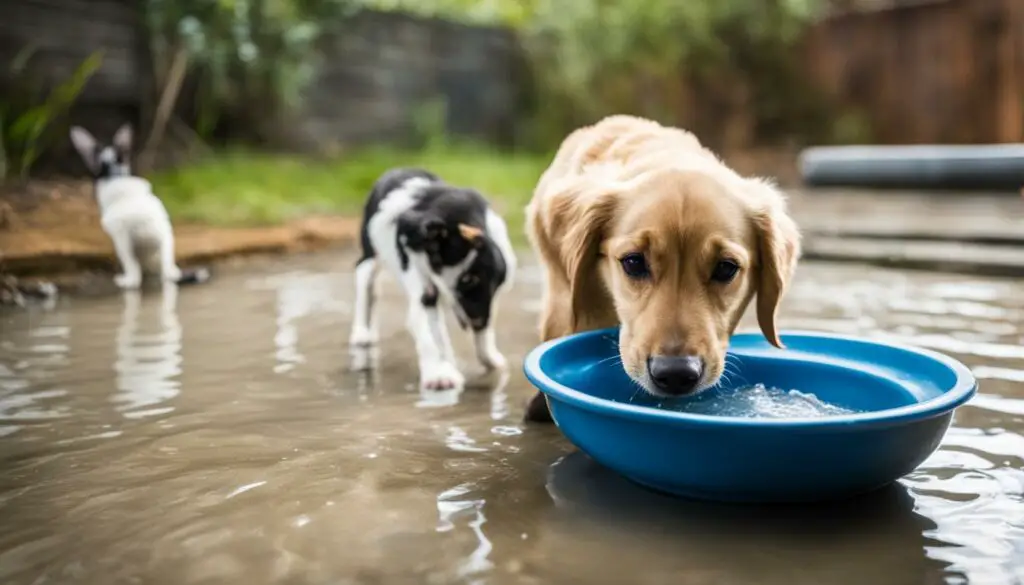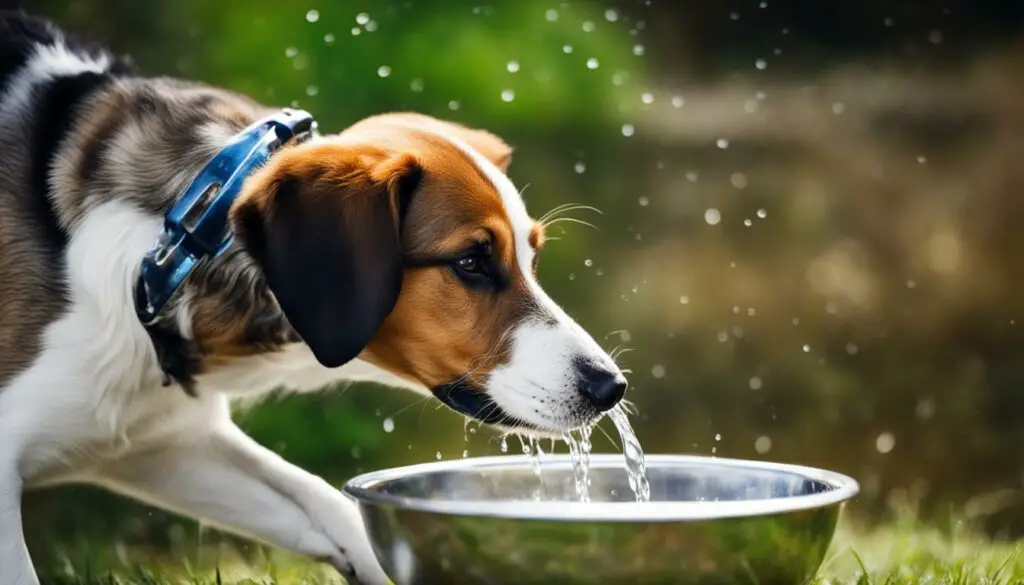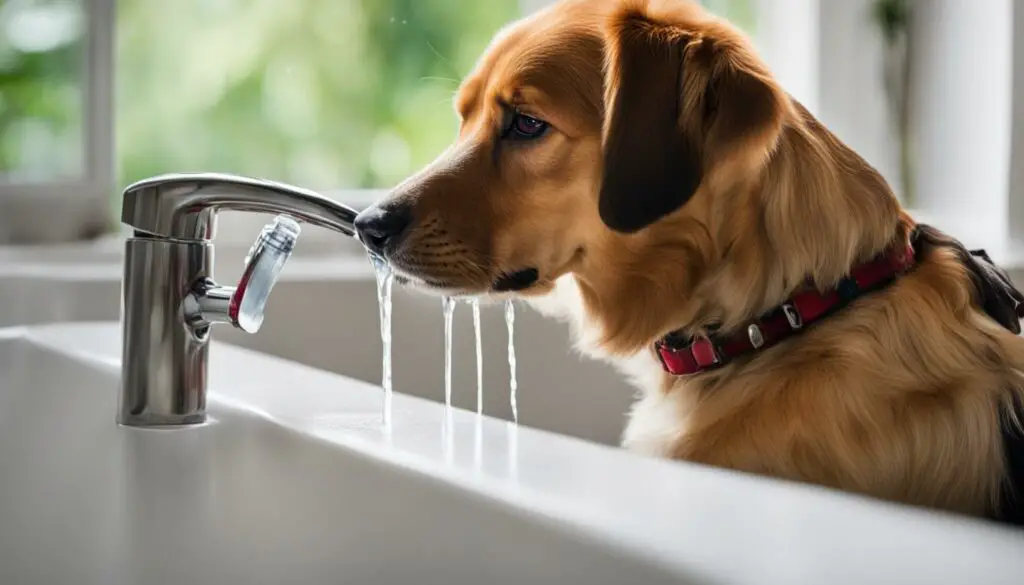As a responsible pet owner, I always prioritize the health and well-being of my furry companions. Recently, I stumbled upon some information regarding dog tap water allergies and the potential symptoms associated with them. While there is no definitive evidence that dogs can be allergic to tap water, it’s crucial to be aware of the possible risks and take precautions to ensure our dogs stay healthy.
Key Takeaways:
- Although there is no conclusive evidence of dogs being allergic to tap water, certain minerals and chemicals found in water can cause urinary issues and skin irritation.
- Hard water, which contains minerals like magnesium, can potentially affect the health of dogs and cats, leading to urinary complications.
- Tap water can contain contaminants such as lead, chlorine, iron, and nitrates, which can cause stomach pain, diarrhea, itching skin, and urinary problems in dogs.
- Allergies to other pets, dust mites, indoor plants, and chemical irritants can also contribute to allergic reactions in dogs, causing various symptoms including skin redness, itching, and respiratory issues.
- If you suspect your dog has allergies, consult with a veterinarian for proper testing and diagnosis. Minimizing allergens in your home, using filtered or bottled water, and maintaining a clean and safe water source are important steps to support your dog’s health.
Effects of Hard Water on Dogs and Cats
Hard water, which contains high levels of minerals such as magnesium, can have a potential impact on the health of dogs and cats. While there is no direct evidence linking hard water to allergies in pets, studies have shown a correlation between areas with very hard water and urinary complications in cats. Additionally, dogs can be susceptible to developing stones and urinary tract infections due to the presence of minerals in the water they consume.
It is important to note that these effects may vary depending on the pet’s individual sensitivity and overall health. Some animals may experience symptoms such as increased thirst, changes in urinary habits, or discomfort, while others may not show any noticeable signs. If you suspect that your pet is experiencing any issues related to hard water, it is advisable to consult with a veterinarian for proper diagnosis and guidance.
To illustrate the potential impact of hard water on pets, consider the following comparative table:
| Dogs | Cats | |
|---|---|---|
| Urinary Complications | Increased risk of stones and urinary tract infections | Correlation between very hard water and urinary issues |
| General Symptoms | Increased thirst, changes in urinary habits | Discomfort, changes in urinary habits |
While it may not be necessary to take immediate action to change your pet’s water source, it is crucial to be mindful of the potential effects of hard water. Monitoring your pet’s health and observing any changes in behavior or well-being can help you determine whether further measures, such as providing filtered or bottled water, are necessary to ensure their comfort and overall health.
Potential Contaminants in Tap Water and Their Effects on Pets
Tap water can contain various contaminants that may negatively impact the health of our beloved pets. It’s essential to be aware of these potential risks and take steps to ensure the well-being of our furry friends. Let’s explore some common contaminants found in tap water and their effects on dogs.
Potential Contaminants
Lead, chlorine, iron, and nitrates are some of the most prevalent contaminants found in tap water. These substances can have detrimental effects on dogs when consumed over time.
“Dogs may experience symptoms such as stomach pain, diarrhea, itching skin, and urinary issues as a result of exposure to these contaminants,” says Dr. Emily Peterson, a veterinarian with expertise in pet health and nutrition.
It’s important to note that the severity of these symptoms can vary depending on the concentration of contaminants present in the water and the individual dog’s sensitivity.
Protecting Your Pet’s Health
While it may not be practical to completely eliminate all contaminants from tap water, there are steps you can take to reduce exposure and protect your pet’s health:
- Consider using a water filtration system specifically designed to remove common contaminants from tap water. This can help provide a safer water source for your pet.
- Regularly monitor your dog’s water intake and look out for any changes in behavior or health that may indicate a reaction to tap water.
- If your dog shows symptoms of allergies or sensitivities after drinking tap water, consult with a veterinarian for further evaluation and guidance.
By being proactive and taking these precautions, we can ensure our pets have access to clean and safe drinking water, minimizing the potential risks associated with tap water contaminants.

Allergies to Dust Mites and Dog Bedding
Dogs can develop allergies to dust mites, which are microscopic insects commonly found in indoor environments. These tiny pests feed on dead skin cells and thrive in warm, humid conditions. Dust mites can be present in your dog’s bedding, carpets, and upholstery, triggering allergic reactions when inhaled or when they come into contact with the skin.
Symptoms of dust mite allergies in dogs may include itching, redness, and inflammation of the skin. Your dog may scratch excessively, chew at their paws, or develop hot spots. In severe cases, respiratory symptoms such as coughing, wheezing, and sneezing may also occur. It is essential to address dust mite allergies to provide relief and improve your dog’s quality of life.
“Dust mite allergies can cause significant discomfort for dogs, leading to skin issues and respiratory problems. Regularly washing your dog’s bedding in hot water and using hypoallergenic materials can help reduce the presence of dust mites and alleviate allergic reactions.”
To minimize dust mite exposure and prevent allergic reactions, it is recommended to wash your dog’s bedding regularly in hot water. This will effectively remove dust mites and their allergens. Additionally, using hypoallergenic dog bedding made from materials that are resistant to dust mites can provide a safe and comfortable resting place for your furry friend.
In severe cases, your veterinarian may recommend allergy testing to identify the specific allergens causing your dog’s reactions. This can help determine whether dust mites are the primary culprit and guide the development of a targeted treatment plan. By addressing dust mite allergies and creating an allergen-free environment, you can help your dog live a happier, healthier life.

Allergies to Other Pets
Dogs, just like humans, can develop allergies to other animals in the household. Whether it’s a new pet that has been introduced or a long-time furry companion, it’s essential to recognize the signs of these allergies and take necessary precautions to keep our dogs comfortable.
Signs of Dog Tap Water Allergy:
- Excessive scratching or itching
- Redness or inflammation of the skin
- Hives or rashes
- Sneezing or coughing
- Watery eyes
- Respiratory issues
If you notice any of these symptoms in your dog, it’s crucial to determine the cause and address it promptly. Allergies to dander can develop at any point in a dog’s life, so even if your dog has been fine with other pets in the past, it doesn’t necessarily mean they won’t develop an allergy later on.
To identify the specific allergen causing the reaction, consult with a veterinarian for proper testing and diagnosis. This will help you implement appropriate measures to manage the allergies effectively.
| Allergy Triggers | Precautions |
|---|---|
| Fur or dander from other pets | Regularly groom and brush your pets to minimize shedding. Keep them in separate areas of the house if necessary. |
| Saliva from other pets | Avoid cross-contamination by not allowing your pets to share food bowls or toys. Keep their living spaces clean and separate. |
| Bedding or blankets used by other pets | Wash bedding and blankets regularly to remove allergens. Consider using hypoallergenic materials. |
By being proactive and taking steps to minimize exposure to the allergen, you can help alleviate your dog’s symptoms and provide them with a more comfortable living environment.

Chemical Skin Irritants and Allergies
When it comes to the health of our beloved dogs, it’s important to be aware of potential allergens that can cause skin irritation and allergic reactions. Chemical irritants found in household cleaners, shampoos, detergents, and soaps can all contribute to allergic reactions in dogs. To ensure the well-being of our furry friends, it’s crucial to identify and eliminate any chemical irritants that may be causing allergies.
“Chemical irritants found in household cleaners, shampoos, detergents, and soaps can cause contact dermatitis and allergic reactions in dogs.”
One way to minimize the risk of chemical allergies is by using all-natural cleaners and organic, unscented detergents. These products are formulated without harsh chemicals that can irritate sensitive dog skin. By opting for these gentler alternatives, we can help prevent skin irritation and promote a healthier environment for our dogs.
Common Chemical Allergens:
- Artificial fragrances: Many scented products contain chemicals that can trigger allergic reactions in dogs.
- Phthalates: These chemicals are often used in plastics and can cause skin irritation.
- Parabens: Widely used as preservatives, parabens can lead to allergic reactions in dogs.
- Formaldehyde: Found in some cleaning products, this chemical can be a potent irritant for dogs.
By avoiding products that contain these common chemical allergens, we can significantly reduce the risk of skin irritation and allergies in our furry companions.
| Product | Chemical Irritants | All-Natural Alternative |
|---|---|---|
| Household Cleaner | Fragrances, Phthalates | All-purpose cleaner with natural ingredients |
| Shampoo | Parabens, Formaldehyde | Organic, unscented shampoo for dogs |
| Detergent | Artificial fragrances | Chemical-free laundry detergent |
| Soap | Phthalates | Gentle, natural soap for dogs |
By being mindful of the products we use around our dogs, we can create a safer and more comfortable environment for them to thrive in. Prioritizing their well-being and avoiding chemical irritants will help reduce the risk of allergic reactions and keep our furry friends happy and healthy.

Allergies to Indoor Plants
Indoor plants can add beauty and freshness to any home. However, it’s important to be aware that some plants can trigger allergic reactions in dogs. Just like humans, dogs can develop allergies to pollen, mold, and other plant-related allergens. Common symptoms of plant allergies in dogs include itchy skin, excessive grooming, rashes, sneezing, and eye discharge.
When selecting indoor plants for your home, it’s essential to choose pet-friendly options that are non-toxic and less likely to cause allergies. Some dog-friendly plants include spider plants, Boston ferns, and bamboo palms. Avoid plants such as lilies, philodendrons, and aloe vera, as they can be toxic to dogs and may trigger allergic reactions.
If you suspect that your dog is allergic to indoor plants, it’s best to consult with a veterinarian. They can help you identify the specific allergen and provide guidance on how to manage your dog’s allergies. In some cases, you may need to remove the allergenic plants from your home or create a designated pet-free area where your dog can spend time without being exposed to potential allergens.

Common Indoor Plants That Can Trigger Allergies in Dogs
| Plant | Symptoms |
|---|---|
| Lilies | Itchy skin, vomiting, kidney failure |
| Philodendrons | Oral irritation, drooling, difficulty swallowing |
| Aloe Vera | Vomiting, diarrhea, tremors |
| Pothos | Oral irritation, vomiting, difficulty breathing |
It’s important to note that while these plants can be problematic for dogs with allergies, every dog is different, and individual reactions may vary. Monitor your dog closely for any signs of discomfort or allergic reactions when introducing new plants to your home.
Sensitivity to Smoke
Just like humans, dogs can be sensitive to smoke and may develop respiratory issues and skin allergies as a result. Exposure to smoke, whether from cigarettes, fireplaces, or other sources, can have a negative impact on your dog’s health. It is important to understand the signs of smoke sensitivity in dogs and take necessary precautions to keep them safe.
Symptoms of smoke sensitivity in dogs may include shortness of breath, coughing, wheezing, watery eyes, sneezing, and difficulty breathing. You may also notice that your dog becomes more lethargic or has a decrease in appetite. These symptoms can be exacerbated in dogs with pre-existing respiratory conditions, such as asthma or chronic bronchitis.
To minimize your pet’s exposure to smoke, it is recommended to create a smoke-free environment in your home. This can be achieved by designating smoking areas outside, ensuring proper ventilation, and using air purifiers to filter out smoke particles. It is also important to avoid burning any materials, such as candles or incense, that can release smoke or irritants into the air.
If you suspect that your dog is sensitive to smoke or is experiencing allergic reactions, it is crucial to consult with a veterinarian for proper diagnosis and treatment. Your vet may recommend medications to alleviate symptoms or suggest lifestyle changes to minimize your dog’s exposure to smoke and other irritants.

Testing for Allergies and Determining the Allergen
If you suspect that your dog may have allergies, it is important to consult with a veterinarian to properly test and diagnose the issue. The vet may suggest performing an elimination trial to identify the specific allergen causing the reaction. During this trial, certain foods or environmental factors are eliminated from your dog’s routine to see if the symptoms subside.
Additionally, keeping a record of any changes in your dog’s environment or diet can help pinpoint the source of the allergy. Note any new products, foods, or plants that your dog has been exposed to and any changes in their symptoms. This information can assist the veterinarian in determining the potential allergen and developing an appropriate treatment plan.
In some cases, the vet may recommend more advanced diagnostic tests, such as blood tests or intradermal skin testing, to further identify the specific allergens affecting your dog. These tests can provide valuable insights into the allergens and help guide the treatment approach. It’s important to follow your vet’s advice and guidance throughout the testing process to ensure accurate results.
Common Allergens in Dogs
Allergies in dogs can be caused by a wide range of allergens. Some common allergens that could be tested for include:
- Pollen
- Dust mites
- Mold spores
- Fleas or other external parasites
- Certain foods (e.g., wheat, soy, dairy)
- Environmental factors (e.g., certain grasses, trees, or weeds)
The specific allergens that affect your dog may depend on various factors, including their breed, genetics, and overall immune system health. By identifying the allergens, you can take appropriate measures to minimize your dog’s exposure and manage their symptoms effectively.
| Allergen | Symptoms |
|---|---|
| Pollen | Sneezing, itching, watery eyes, respiratory issues |
| Dust mites | Itchy skin, redness, inflammation |
| Mold spores | Respiratory issues, coughing, sneezing |
| Fleas or other external parasites | Intense itching, flea allergy dermatitis |
| Certain foods | Digestive issues, skin problems, ear infections |
| Environmental factors | Skin irritation, itching, rashes |
Remember, accurate testing and identification of the allergen are crucial for devising an effective allergy management plan for your dog. Work closely with your veterinarian to ensure proper testing and diagnosis, and follow their recommendations for treatment and prevention strategies.
Minimizing Allergens in Your Home
When it comes to managing your dog’s allergies, minimizing allergens in your home is crucial. By implementing a few simple practices, you can create a healthier environment for your furry friend. Regular cleaning and washing of bedding can help remove dust mites and other allergens that may trigger a reaction. Using all-natural cleaning products and unscented detergents can also reduce the risk of skin irritation and allergic reactions.
Adding a HEPA (High-Efficiency Particulate Air) filter to your home is another effective way to minimize allergens in the air. These filters are designed to trap small particles such as dust, pollen, and pet dander, improving overall air quality. By reducing the amount of airborne allergens, you can help alleviate your dog’s symptoms and create a more comfortable living space.
Table: Tips for Minimizing Allergens in Your Home
| Tip | Description |
|---|---|
| Regular cleaning | Regularly clean your home to remove dust, pet dander, and other allergens. Vacuum carpets and upholstery, dust surfaces, and mop floors. |
| Frequent washing of bedding | Wash your dog’s bedding and blankets frequently to remove dust mites and allergens. Use scent-free, hypoallergenic detergents. |
| Use all-natural cleaning products | Avoid using harsh chemicals that can irritate your dog’s skin. Opt for all-natural cleaning products that are safe for both you and your pet. |
| Install a HEPA filter | Add a HEPA filter to your home’s HVAC system or use standalone air purifiers to remove allergens from the air. |
Remember to keep an eye on your dog’s behavior and symptoms to determine if your efforts to minimize allergens are working. If your dog continues to experience allergy-related issues, it’s important to consult with a veterinarian for further guidance and potential treatment options.
Giving Your Dog Filtered or Bottled Water
When it comes to keeping our furry friends healthy, providing them with clean and safe water is essential. While tap water is generally safe for dogs to drink, some dogs may have sensitivities or allergies to certain contaminants or chemicals that can be found in tap water. If you notice signs of dog tap water allergy, such as excessive itching, gastrointestinal issues, or urinary problems, it may be worth considering giving your dog filtered or bottled water.
Filtered or bottled water can be a good alternative for dogs with sensitivities to tap water. The filtration process helps remove impurities and potential allergens, such as chlorine, lead, and nitrates, that may be present in tap water. This can help prevent allergic reactions and minimize the risk of urinary issues or digestive problems in sensitive dogs.
When choosing filtered or bottled water for your dog, it is important to select high-quality sources. Look for reputable brands that provide information about their water sources and filtration methods. It’s also crucial to ensure that the water is stored in clean containers and that you regularly replace the water to maintain freshness.

Remember, providing your dog with filtered or bottled water should not replace regular veterinary care. If you suspect your dog has allergies or sensitivities to tap water, it’s essential to consult with a veterinarian who can evaluate your pet’s health and provide appropriate guidance. By taking proactive steps to ensure your dog’s water source is clean and free from potential allergens, you can help promote their overall well-being and provide them with the best possible hydration.
Is Tap Water Safe for Dogs?
When it comes to ensuring the well-being of our furry friends, one important consideration is the quality of the water they consume. Tap water is widely available and accessible for both humans and dogs, but is it safe to give to our canine companions? While tap water that meets regulatory standards is generally safe for dogs to drink, certain factors such as sensitivities and allergies to tap water can impact their health.
Sensitivity to tap water can manifest in dogs as symptoms like skin irritation, digestive issues, and urinary complications. Some dogs may have specific sensitivities to the minerals, chemicals, or contaminants found in tap water, leading to adverse reactions. If you notice any signs of tap water allergy in your dog, such as excessive itching, redness, or changes in urination patterns, it may be worth exploring alternative water sources.
One popular alternative to tap water for dogs is filtered or bottled water. These options remove potential contaminants and provide a cleaner drinking experience for your pet. Filtered water can be particularly beneficial for dogs with sensitivities or allergies to tap water. It is important to choose high-quality filtration systems or trusted bottled water brands to ensure the water is safe and free from harmful substances.

Consulting with a veterinarian is essential if you suspect your dog has sensitivities or allergies to tap water. They can guide you in identifying and managing any potential issues, as well as recommend suitable water sources for your dog’s specific needs. Additionally, monitoring your dog’s water intake and making necessary adjustments can play a vital role in maintaining their health and well-being.
While tap water can be safe for dogs in general, it is crucial to be aware of any sensitivities or allergies your pet might have. By taking proactive measures and ensuring access to clean and suitable water sources, you can help promote a healthier lifestyle for your furry companion.
Importance of Water Quality for Dog Health
Ensuring clean and safe water for your beloved canine companion is crucial for their overall health and well-being. Poor water quality can lead to various health issues, including urinary complications, skin irritation, and digestive problems. By prioritizing water quality, you can help prevent potential dog tap water allergy symptoms and promote a healthier lifestyle for your furry friend.
One way to maintain water quality is by regularly testing and monitoring the water source. This can help identify any contaminants or harmful substances that could be present in the tap water. By staying informed about the quality of the water, you can take appropriate measures to address any issues that may arise.
Another important consideration is the use of filtration systems or bottled water. These options can provide an extra layer of purification, removing potential allergens or chemicals that may trigger dog water allergy symptoms. Filtered or bottled water can be especially beneficial for dogs with known sensitivities or allergies to tap water, ensuring they have access to clean and safe drinking water.
Minimizing water-related allergies and sensitivities:
In addition to monitoring water quality, there are other steps you can take to minimize the risk of dog water allergies and sensitivities:
- Regularly clean and wash your dog’s water bowl to prevent the buildup of bacteria or contaminants.
- Provide fresh water daily and replace it if it becomes stagnant or dirty.
- Avoid using cleaning products or detergents near the water bowl, as the residue can potentially contaminate the water.
- Consider using stainless steel or ceramic bowls, as they are less likely to leach chemicals into the water compared to plastic bowls.
By following these practices and prioritizing water quality, you can help safeguard your dog’s health and minimize the risk of dog tap water allergy symptoms. Remember to consult with a veterinarian if you notice any unusual symptoms or suspect your dog may have allergies or sensitivities to water or other substances. Your vet can provide guidance and recommend appropriate treatment options to keep your furry friend happy and healthy.
Conclusion
After exploring the potential risks and effects of tap water on dogs, it is clear that while allergies to tap water may not be common, certain minerals, chemicals, and contaminants in water can cause health issues in our furry friends. It is essential to be proactive in ensuring the water quality our dogs consume is clean and safe.
Regularly testing and monitoring the water quality, especially for the presence of lead, chlorine, iron, and nitrates, can help prevent symptoms such as stomach pain, diarrhea, itching skin, and urinary issues in dogs. If your dog shows signs of allergic reactions or sensitivity to tap water, it may be worth considering filtered or bottled water as a safer alternative.
Minimizing allergens in your home, such as dust mites, chemicals, smoke, and indoor plants, can also help alleviate potential allergic reactions in your dog. By regularly cleaning and washing bedding, using all-natural materials, and improving indoor air quality with a HEPA filter, you can create a more comfortable environment for your pet.
In conclusion, while tap water can be safe for dogs to drink if it meets regulatory standards, it is important to be mindful of your dog’s specific sensitivities and take the necessary precautions. By providing clean and filtered water, monitoring their water intake, and consulting with a veterinarian, you can ensure that your dog stays hydrated and healthy.
FAQ
Can dogs have an allergy to tap water?
While there is no conclusive evidence of dogs being allergic to tap water, certain minerals and chemicals in water can cause urinary issues and skin irritation in dogs.
Can hard water affect dogs and cats?
Yes, minerals in hard water can increase water hardness and potentially affect the health of dogs and cats. Studies have shown a correlation between urinary complications in cats and areas with very hard water.
What contaminants can be found in tap water and how can they affect pets?
Tap water can contain lead, chlorine, iron, and nitrates, among other contaminants. These can cause symptoms such as stomach pain, diarrhea, itching skin, and urinary issues in dogs. Prolonged exposure can lead to more serious health problems.
Can dust mites cause allergies in dogs?
Yes, dust mites are a common allergen for both humans and pets. Dogs can develop allergies to dust mites, which can cause itching, redness, and inflammation of the skin. Regularly washing your dog’s bedding can help remove dust mites.
Can dogs be allergic to other pets?
Yes, dogs can be allergic to other animals in the household, including new pets that are introduced. Allergies to dander can develop at any point in a dog’s life.
Can certain household cleaners and detergents cause allergies in dogs?
Yes, certain household cleaners, shampoos, detergents, and soaps can cause contact dermatitis and allergic reactions in dogs. Using all-natural and unscented products can help prevent skin irritation.
Can plants trigger allergies in dogs?
Yes, some indoor and outdoor plants can trigger allergic reactions in dogs, including symptoms such as itchy skin, excessive grooming, rashes, sneezing, and eye discharge.
Can smoke cause allergies in dogs?
Yes, dogs, especially cats, can be sensitive to smoke and develop respiratory issues and skin allergies. It is important to minimize your pet’s exposure to smoke to prevent allergic reactions.
How can I test for allergies in my dog?
If you suspect your dog has allergies, it is important to consult with a veterinarian for proper testing and diagnosis. Elimination trials can help identify the specific allergen causing the reaction.
How can I minimize allergens in my home?
Regular cleaning, washing bedding frequently, using all-natural materials, and adding a HEPA filter to your home can help reduce allergens and improve air quality for your dog.
Is filtered or bottled water a better option for dogs with sensitivities?
Filtered or bottled water can be a safer option for dogs with sensitivities to tap water as it removes contaminants and chemicals that may cause allergies or urinary issues in dogs.
Is tap water safe for dogs to drink?
Tap water can be safe for dogs to drink if it meets regulatory standards and does not contain harmful contaminants. However, dogs with specific sensitivities or allergies to tap water may benefit from filtered or bottled water.
How important is water quality for dog health?
Clean and safe water is essential for maintaining your dog’s health and well-being. Poor water quality can lead to various health issues, including urinary complications, skin irritation, and digestive problems.








